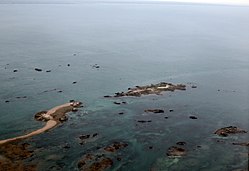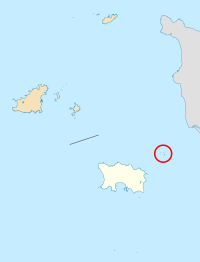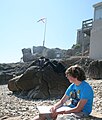Écréhous
| Les Écréhous | |
 Aerial view of Les Écréhous. | |
|---|---|
| Location | |
| Location: | 49°16’59"N, 1°55’59"W |
| Data | |
The Écréhous (or Les Écréhous; in Jèrriais: Êcrého) are a group of islands and rocks situated six miles north-east of Jersey (eight miles from France). They form part of the Bailiwick of Jersey and are administratively part of the Parish of St Martin.
The most significant islets in the group are:
- Maîtr'Île
- La Marmotchiéthe
- Lé Bliantch'Île
others include:
- Les D'mies
- La Grand' Naithe
- L'Êtchièrviéthe
- Lé Fou
- La Froutchie
All but the three largest are submerged at high tide. There are no permanent residents on the islands and there is no fresh water there. Due to erosion, they are now much smaller than they may have been within historic times. Maîtr'Île is the largest of the islets and measures approximately 300 metres in length.[1] There are a small number of fishermen's huts, some used as holiday residences, on the largest islets, and one official building, a customs house, on La Marmotchiéthe.
The name 'Ecréhous' is Norse in origin. "Esker" (as in "Skerry") means a stony bank and -hou derives from the Norse holm, meaning island (an element found also in the names of Jethou, Lihou, Brecqhou, Burhou and other islets). The first part of the name appears to be traced back to the Norse word sker, meaning reef. The Ecréhous are actually, geologically, part of the same island group as Les Dirouilles (west) and Les Pierres de Lecq ('the Paternosters') (further west).
History

In 1203, shortly before the loss of the landward part of Normandy in 1204, King John as Duke of Normandy granted the Ecréhous to the Abbey of Valricher that they might build a church there. In 1309 it was reported that a prior was living in the Ecréhous with one monk and a servant; a navigation light was lit every night.[2] In 1413 alien priories were suppressed and the monks returned to Valricher, and their church and priory on La Maîtr'Île fell into ruins.[3] The chapel measured 10 ft 3 ins in width and 16 ft 6 ins in length; the priory accommodation for the monks formed an extension to the chapel.[2]
In the 17th century the Écréhous were used by smugglers.
Though they are only inhabited sporadically by holidaymakers and fishermen, in the past there have been more permanent residents on Les Ecréhous due to more abundant vegetation. Two eccentrics who lived on the Ecréhous for a long time proclaimed themselves to be Le Roi des Ecréhous (The king of the Ecréhous) and claimed that sovereignty over the islands belonged to them. Philippe Pinel lived on Bliantch'Île from 1848 to 1898 and exchanged gifts with Queen Victoria. In the 1960s and 1970s Alphonse Le Gastelois found refuge in the islands from public suspicion of his being the Beast of Jersey (a notorious pederast, though Le Gastelois was cleared of suspicion when the real culprit was arrested).
Sovereignty over the Écréhous was long disputed between the United Kingdom and France. In the 19th and early 20th centuries there were several occasions on which nominal British control was displayed, for example with flags and buoys. To settle the matter, in 1950 the United Kingdom and France went to the International Court of Justice for friendly discussions to decide to which country the Minquiers and Écréhous belonged. The French fished in the waters, but Jersey exercised various administrative rights. The Court considered the historical evidence, and in its Judgment of 17 November 1953 awarded the islands to Jersey.[4]
The French Government accepted the position, but Norman fishermen often did not. In 1993 and again in 1994, French 'invaders' from mainland Normandy landed on the Ecréhous and raised Norman flags. This was done partly in protest against Channel Island fishing regulations and partly because they wanted the Ecréhous to be recognised as part of France. The 1994 'invasion' was monitored closely by States Police from Jersey, and the Union Flag that had been pulled down in 1993 was guarded by policemen. In the end, after only minor trouble being caused, the Frenchmen had lunch on the islands before going back home. A priest who was part of the expedition said a popish mass on the islands for the first time since the ruined abbey was in use (some hundreds of years). He created an outline of a church and altar using vraic he collected from the sea.
La Marmotchiéthe is depicted on the 2010 issue Jersey 50 pound note.
In 2005 the States of Jersey designated the Écréhous as an area under the Ramsar convention, signifying it was a wetland of International importance and giving it an enhanced status and recognition, a management plan for the area has yet to be published.
Pilotage and sailing
Entrance to the island can be difficult. However, it is possible to visit at all states of tide with the main entrance from the southwest.[5]
Pictures
-
19th century illustration
-
Maîtr'Île Flag Mast 2008
-
Maîtr'Île Flag Mast 2008
-
Maîtr'Île from the South
-
Looking South from Maîtr'Île
Outside links
- Les Écréhous: a Toponymy (Sociéte jérsiaise)
- International Court of Justice: Case Summaries
- Accord commercial sur la pêche entre la France et Jersey
- The Ecréhous
References
- ↑ Channel Islets, Coysh, Guernsey 1985
- ↑ 2.0 2.1 Balleine's History of Jersey, 1998
- ↑ The Bailiwick of Jersey, GR Balleine, 1951
- ↑ ICJ, Summary of the Judgment of 17 November 1953
- ↑ The Channel Islands Pilotage Book by Peter Carnegie
- Les Ecrehous, Jersey: History and Archaeology of a Channel Island Archipelago (ISBN 0-901897-21-3) by Warwick Rodwell.
| The Channel Islands |
|---|
|
Bailiwick of Guernsey: Guernsey • Alderney • Sark • Herm • Brecqhou • Burhou • Ortac • Les Casquets • Jethou • Lihou • Crevichon • Les Houmets |
|
Bailiwick of Jersey: Jersey • Les Écréhous • La Motte • Les Minquiers • Pierres de Lecq • Les Dirouilles |




